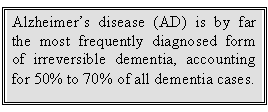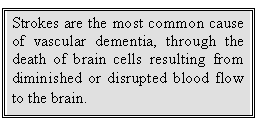TYPES OF DEMENTIA
Alzheimer’s disease (AD) is by far the most frequently diagnosed form of irreversible dementia, accounting for 50% to 70% of all dementia cases (5). Early-onset AD, which develops before the age of 65, is relatively rare, accounting for less than 10% of all AD patients (6). Late-onset AD, occurring after age 65, is the most common form. The symptoms of both types of AD are the same; however, the progression of the disease is often more rapid among early-onset patients.

The onset of AD is usually gradual, normally beginning with mild memory lapses and problems finding the right words. Symptoms worsen over a period of a few years until job performance is affected, activities such as bill paying become difficult, confusion about places leads to getting lost, and the individual loses initiative and spontaneity. This early stage of the disease usually lasts from two to four years and is when the patient normally is diagnosed.
The second, or middle, stage of AD is the longest and can last up to 10 years. This stage is marked by psychiatric and behavioral changes such as anxiety, paranoia, irritability, or depression. There is increasing memory loss; shortening of attention span; loss of impulse control; difficulty in reading, writing, understanding numbers, and thinking logically; and perceptual motor problems. It is during this stage that close friends and family members often are not recognized.
In the third, or terminal, stage of the disease, the patient has little or no capacity for self-care, loses the ability to communicate with words, suffers weight loss even with a good diet, and cannot control bodily functions. There may be difficulty in swallowing and seizures may occur. The last stage of AD usually lasts from one to three years.
The pathology of AD is characterized by hard, insoluble plaques between the nerve cells in the hippocampus and other areas of the cerebral cortex and neurofibrillary tangles within the cells. Plaques are made up of beta-amyloid. Amyloid is a term that refers to protein fragments that are produced naturally by the body and would be broken down and eliminated in a healthy brain. Beta-amyloid is a protein fragment that is snipped from a larger protein known as an amyloid precursor protein (APP), which is important to the survival of neurons by helping the cells repair themselves after injury. APP attaches to the cell membrane, positioning itself both inside and outside of the membrane. When AD is present, certain enzymes cut the APP into fragments; the beta-amyloid fragments then clump together outside of the cells, joining with non-nerve cells and other molecules to form plaques. The plaques interfere with the neurons’ ability to communicate with each other, eventually destroying whole regions of the brain.
Neurofibrillary tangles are made up of insoluble twisted fibers that accumulate within the nerve cell. A healthy neuron has an internal support system made up of structures called microtubules that transport nutrients from one part of the cell to another. Part of the microtubule consists of a protein called tau. In AD, the tau protein is abnormal and begins to pair with other tau strands, becoming tangled. This causes the microtubule to collapse, destroying the neuron’s transport system and eventually causing the death of the cell.
 Vascular
dementia isthe second most frequently diagnosed
type of dementia. It is estimated that it comprises from 10% to 20% of
all dementia, and is mixed with AD in another 20%. The symptoms of vascular
dementia and AD are often the same, but the onset is more abrupt in vascular
dementia. While AD is marked by a gradual worsening of symptoms, vascular
dementia usually follows an irregular, stepwise pattern, with long periods
of stability before a sudden worsening. Gait problems frequently are
noticed in the beginning stages of vascular dementia, unlike AD.
Vascular
dementia isthe second most frequently diagnosed
type of dementia. It is estimated that it comprises from 10% to 20% of
all dementia, and is mixed with AD in another 20%. The symptoms of vascular
dementia and AD are often the same, but the onset is more abrupt in vascular
dementia. While AD is marked by a gradual worsening of symptoms, vascular
dementia usually follows an irregular, stepwise pattern, with long periods
of stability before a sudden worsening. Gait problems frequently are
noticed in the beginning stages of vascular dementia, unlike AD.
Strokes are the most common cause of vascular dementia, through the death of brain cells resulting from diminished or disrupted blood flow to the brain. Vascular dementia can develop from one large stroke or from a series of small strokes (transient ischemic attacks, or TIAs) that don’t seem to cause permanent damage at the time. However, the buildup of damage from TIAs can cause what is termed multi-farct dementia (MID). While strokes are the most common cause of vascular dementia, arteriosclerosis (hardening of the arteries) can also be at fault by extensively narrowing or blocking arteries and causing decreased blood flow. This normally occurs among older persons with high blood pressure or high cholesterol levels. Binswanger’s disease is a rare form of vascular dementia that affects the white matter deep within the brain. Hypertension is the main predisposing factor to Binswanger’s; its onset occurs around 50 years of age and symptoms include slowed thinking and reacting, walking difficulty, emotional swings, and loss of bladder control early in the disease.
Lewy Body disease has symptoms similar to AD and Parkinson’s disease, including memory problems, confusion, hallucinations, and language problems. In this case, however, dementia is caused by tiny round protein deposits (“Lewy bodies”) that form in the nerve cells and disrupt cerebral functioning. It has been suggested that Lewy Body disease may be the second most common form of dementia in elderly patients (7).
There are other, less common, types of irreversible dementia. In frontotemporaldementia (FTD), damage is localized in the front part of the brain, resulting in personality and behavioral changes and language deficits before memory loss. FTD has a strong genetic component. Pick’s disease, a form of FTD, is marked by “Pick bodies,” another form of abnormal structure found within nerve cells that causes them to swell and eventually fail to function. Creutzfeldt-Jakob disease is caused by an infectious organism and progresses rapidly with dementia, involuntary movements, blindness, and finally coma. Parkinson’s disease can eventually result in dementia, beginning with slowed thinking and progressing to confusion. Dementia usually develops in the latter stages of Huntington’s disease, an inherited, degenerative disease of the nervous system.